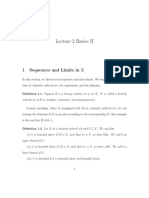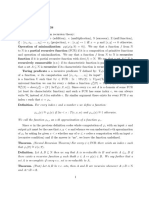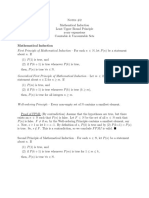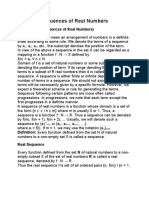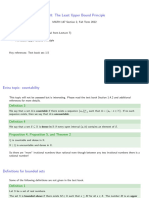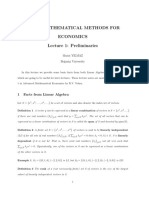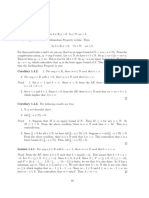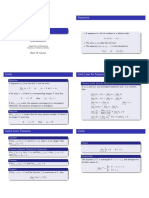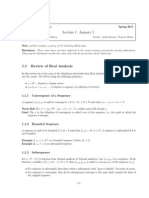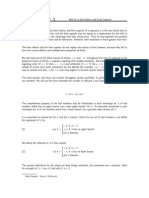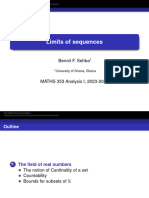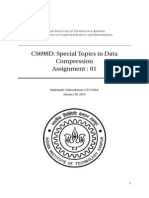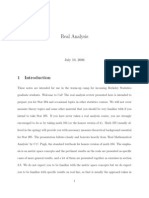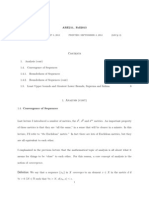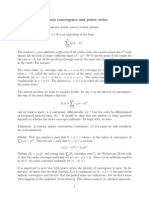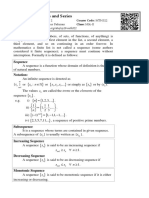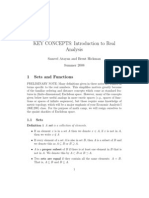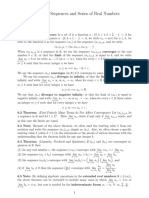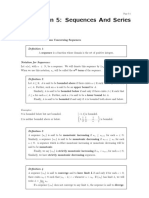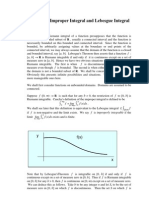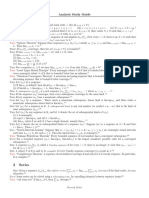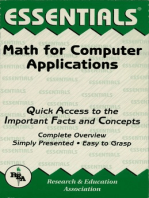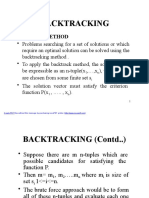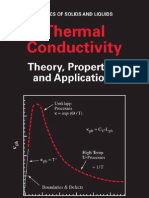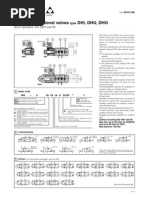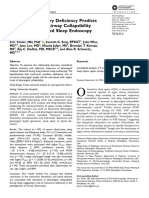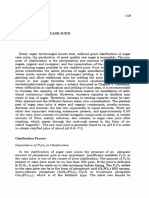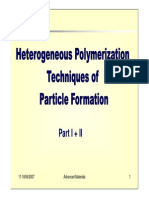Analysis Definitions. Let S Be A Subset of R.: A) L B) For Each Lower Bound L of S It Holds That L L
Analysis Definitions. Let S Be A Subset of R.: A) L B) For Each Lower Bound L of S It Holds That L L
Uploaded by
adi3333Copyright:
Available Formats
Analysis Definitions. Let S Be A Subset of R.: A) L B) For Each Lower Bound L of S It Holds That L L
Analysis Definitions. Let S Be A Subset of R.: A) L B) For Each Lower Bound L of S It Holds That L L
Uploaded by
adi3333Original Description:
Original Title
Copyright
Available Formats
Share this document
Did you find this document useful?
Is this content inappropriate?
Copyright:
Available Formats
Analysis Definitions. Let S Be A Subset of R.: A) L B) For Each Lower Bound L of S It Holds That L L
Analysis Definitions. Let S Be A Subset of R.: A) L B) For Each Lower Bound L of S It Holds That L L
Uploaded by
adi3333Copyright:
Available Formats
Chapter 1
Analysis
Definitions. Let S be a subset of R.
1. An element uR is said to be an upper bound of S if for all xS, xu. If S has an upper
bound, then we also say that S is bounded above.
2. An element l R is said to be a lower bound of S if for all x S, l x. If S has a lower
bound, then we also say that S is bounded below.
3. The set S is said to be bounded if it is bounded above and bounded below.
Any finite set S is bounded.
Definitions. Let S be a subset of R.
1. An element u
R is said to be a least upper bound of S (or a supremum of S if
a) u
is an upper bound of S, and
b) for each upper bound u of S it holds that u
u.
2. An element l
R is said to be a greatest lower bound of S (or an infimum of S) if
a) l
is a lower bound of S, and
b) for each lower bound l of S it holds that l l
.
If the least upper bound of a subset S of R exists, then it is unique.
When the supremum and the infimum of a set belong to the set, we give them the
following familiar special names:
Definitions.
1. If supS S, then supS is called a maximum of S, denoted by max S.
2. If inf S S, then inf S is called a minimum of S, denoted by min S.
For the sets Z and R, sup, inf, max, min do not exist.
For the set , sup, inf, max, min do not exist.
The Least Upper Bound Property.
Any non-empty subset of R that is bounded above, has a least upper bound.
In other words, for a subset S R, if
1. =
2. and S has an upper bound,
then sup S exists.
Theorem (Archimedean property). If x, y R and x > 0, then there exists an n N such
that y < nx.
As a consequence of the Archimedean property we are now able to prove that the set N
of natural numbers is not bounded above.
Intervals
Interval - An interval is a set consisting of all the real numbers between two given real
numbers, or of all the real numbers on one side or the other of a given number.
Definitions
1. The absolute value of a real number x is denoted by |x|, and it is defined as follows:
2. The distance between two real numbers x and y is the absolute value |x y| of
their difference
Theorem
Sequences and Limits
Definition. A sequence is a function f : N R.
lim a
n
= L, (where L is the limit of the sequence)
Definition. The sequence (a
n
)
nN
is said to converge to L if for every real number > 0,
there exists an N N (possibly depending on ) such that for all n > N, |a
n
L|<.
Then we say that (a
n
)
nN
is convergent with limit L and write
lim a
n
= L.
If there does not exist a number L such that lim a
n
= L, then the sequence
(a
n
)
nN
is said to be divergent.
Note that |a
n
L| < iff a
n
(L , L + ).
Theorem A convergent sequence has a unique limit.
Bounded and Monotone Sequence
Definition. A sequence (an)nN is said to be bounded if there exists a real number
M > 0 such that
Theorem If a sequence is convergent, then it is bounded.
Definitions. A sequence (an)nN is said to be
monotonically increasing if for all n N, an an+1,
strictly increasing if for all n N, an < an+1,
monotonically decreasing if for all n N, an an+1,
strictly decreasing if for all n N, an > an+1,
monotone if it is either monotonically increasing or monotonically decreasing.
Theorem If a sequence is monotone and bounded, then it is convergent.
Algebra of Limits
The Sandwich Theorem
Let (a
n
) nN, (b
n
) nN be convergent sequences with the same limit, that is,
lim an = lim bn
If (c
n
) nN is a third sequence such that for all nN, a
n
c
n
b
n
,
then (c
n
)nN is also convergent with the same limit, that is,
lim a
n
= lim c
n
= lim b
n
Subsequences - Let (a
n
) nN be a sequence and let (n
k
)kN be a strictly increasing
sequence of natural numbers. Then (a
nk
)kN is called a subsequence of (a
n
)nN.
Theorem If (a
n
)
nN
is a convergent sequence with limit L, then any subsequence of
(a
n
)
nN
is also convergent with the limit L.
Theorem Every sequence has a monotone subsequence.
Theorem (Bolzano-Weierstrass
theorem.) Every bounded sequence has a con-
vergent subsequence.
Continuity
Continuous functions preserve convergent sequences
Theorem Let I be an interval in R and let c I. Suppose that f : I R is afunction. Then f
is continuous at c iff
for every convergent sequence (x
n
)
nN
contained in I with limit c, (f(x
n
))
nN
is
convergent and lim f(x
n
) = f(c).
Restrictions and compositions of function
Definition. If f : I R and g : J R are functions such that for al l x I , f (x) J ,
then the composition of g with f, is the function g f : I R defined by
(g f)(x) = g(f(x)), x R.
Theorem If f : I R is continuous at c I and g : J R is continuous at f(c) (with f(x)J
for all xI), then gf is continuous at c.
Intermediate Value theorem
Theorem If f : [a, b] R is continuous and y is such that f(a) y f(b) or f(b) y f(a),
then there exists a c [a,b] such that f(c) = y.
Extreme Value theorem
Theorem Let [a, b] be any closed and bounded interval and let f : *a, b+ R be a
continuous function. Then there exists c [a, b] such that
f(c) = sup{f(x) | x [a,b]},
and there exists d [a, b] such that
f(d) = inf {f(x) | x [a,b]}.
You might also like
- Vaughan's Lecture Notes On Real AnalysisDocument76 pagesVaughan's Lecture Notes On Real AnalysispriannaNo ratings yet
- Real Analysis Cheat SheetDocument8 pagesReal Analysis Cheat SheetJoannaWilliamsNo ratings yet
- 70 Shell Scripting Interview QuestionsDocument10 pages70 Shell Scripting Interview Questionskamakom78No ratings yet
- Analysis Cheat SheetDocument4 pagesAnalysis Cheat Sheetjc224No ratings yet
- Real Analysis Definitions (Real Numbers) :: DPQ M PeDocument12 pagesReal Analysis Definitions (Real Numbers) :: DPQ M Pebkjr2008No ratings yet
- C RealDocument8 pagesC Realaliez541537340No ratings yet
- Calculus 1 Topic 1Document13 pagesCalculus 1 Topic 1muradNo ratings yet
- Sequences and Limit of Sequences: 4.1 Sequences: Basic de NitionsDocument12 pagesSequences and Limit of Sequences: 4.1 Sequences: Basic de Nitionsapolitano1No ratings yet
- Semester 1 NotesDocument31 pagesSemester 1 Notespravankarjog12345678No ratings yet
- Analysis Pm20002: in This Module We Deal With Sequences, Series and Functions of One Real Variable. The Main Subjects AreDocument53 pagesAnalysis Pm20002: in This Module We Deal With Sequences, Series and Functions of One Real Variable. The Main Subjects AreTom DavisNo ratings yet
- Lecture 2 Basics IIDocument9 pagesLecture 2 Basics IIskylarNo ratings yet
- Calculus Topic1Document20 pagesCalculus Topic1troy.throwieng.1992No ratings yet
- 1 Preliminaries: K J 1 2 K JDocument8 pages1 Preliminaries: K J 1 2 K JSiraj Ud-DoullaNo ratings yet
- Mathanalysis2 04Document5 pagesMathanalysis2 04이태호No ratings yet
- Mathematical Induction PDFDocument8 pagesMathematical Induction PDFGrace Danna PandoroNo ratings yet
- Sequences of Real NumbersDocument55 pagesSequences of Real NumbersVijay ChhipaNo ratings yet
- Btech 1st Sem: Maths: Sequence and SeriesDocument14 pagesBtech 1st Sem: Maths: Sequence and SeriesTechno India Group50% (4)
- Practical Guide 03 Power SeriesDocument8 pagesPractical Guide 03 Power SeriesEmilNo ratings yet
- Ma1102 STDocument89 pagesMa1102 STAbishek ShivramNo ratings yet
- D 3 Lecture 1Document14 pagesD 3 Lecture 1Manoj Kumar GuptaNo ratings yet
- Lecture 8Document7 pagesLecture 8The tricksterNo ratings yet
- EC521 - Lecturee 1Document8 pagesEC521 - Lecturee 1Tayhan OzenNo ratings yet
- Archimedean PropertyDocument9 pagesArchimedean PropertyErinda T. NNo ratings yet
- Sequences CookDocument2 pagesSequences CookJohn TanNo ratings yet
- SequencesDocument5 pagesSequencesSiva Kumar GaniNo ratings yet
- Infinite Sequences Lecture NotesDocument4 pagesInfinite Sequences Lecture NotesS.m. ChandrashekarNo ratings yet
- SC607 2015 Lecture01Document2 pagesSC607 2015 Lecture01Ankit KumarNo ratings yet
- Lecture 5Document9 pagesLecture 5The tricksterNo ratings yet
- Notes On Lim Sup and Lim InfDocument7 pagesNotes On Lim Sup and Lim InfVishak H PillaiNo ratings yet
- Lecture2 Sequences 1Document36 pagesLecture2 Sequences 1NtobeaNo ratings yet
- Data Compression SolutionDocument11 pagesData Compression SolutionMuktinath VishwakarmaNo ratings yet
- Real Analysis: July 10, 2006Document42 pagesReal Analysis: July 10, 2006Mutt30No ratings yet
- Topic 13 - Sequence and Its ConvergenceDocument17 pagesTopic 13 - Sequence and Its ConvergenceMoksh YadavNo ratings yet
- Sequences: Convergence and Divergence PDFDocument49 pagesSequences: Convergence and Divergence PDFstvo49100% (2)
- TH TH N N N N J: Typeset by AMS-TEX 1Document9 pagesTH TH N N N N J: Typeset by AMS-TEX 1PaolaNo ratings yet
- MathAnalysis2 13 GsDocument8 pagesMathAnalysis2 13 GsramboriNo ratings yet
- 5 Sequences: N N N N 0 1Document9 pages5 Sequences: N N N N 0 1Rosa VidarteNo ratings yet
- NUS Complex Analysis 2.2.2Document19 pagesNUS Complex Analysis 2.2.2Teo Liang WeiNo ratings yet
- D 2 Lecture 2Document22 pagesD 2 Lecture 2dmupscresourceNo ratings yet
- 1 Sequences of Real NumbersDocument17 pages1 Sequences of Real NumbersPblock SaherNo ratings yet
- Uniform Convergence and Power SeriesDocument5 pagesUniform Convergence and Power Series1br4h1m0v1cNo ratings yet
- Integral CalculusDocument6 pagesIntegral Calculusaryanqureshi227No ratings yet
- Week 9Document5 pagesWeek 9Thamas Prakash GaykawadNo ratings yet
- Applied Mathematics II Lecture NoteDocument40 pagesApplied Mathematics II Lecture NoteSagni LamessaNo ratings yet
- Sequences and Limit of Sequences: 4.1 Sequences: Basic de NitionsDocument33 pagesSequences and Limit of Sequences: 4.1 Sequences: Basic de NitionsHimraj Bachoo100% (1)
- Real Analysis Study Materials Part-1Document26 pagesReal Analysis Study Materials Part-1kavi080716No ratings yet
- Summable PDFDocument16 pagesSummable PDFMaria Jose de las mercedes Costa AzulNo ratings yet
- sp19 mth322 Pre ch02 PDFDocument6 pagessp19 mth322 Pre ch02 PDFsimiNo ratings yet
- KEY CONCEPTS: Introduction To Real Analysis: 1 Sets and FunctionsDocument13 pagesKEY CONCEPTS: Introduction To Real Analysis: 1 Sets and FunctionsSamudaya UluwadugeNo ratings yet
- Chap 6 SeriesDocument14 pagesChap 6 SeriesGrace HeNo ratings yet
- MA 105 D3 Lecture 1: Ravi RaghunathanDocument19 pagesMA 105 D3 Lecture 1: Ravi RaghunathanmanishNo ratings yet
- 03 Sequences (Series)Document27 pages03 Sequences (Series)chi_nguyen_100No ratings yet
- Introduction To Shape Optimization: Noureddine IgbidaDocument20 pagesIntroduction To Shape Optimization: Noureddine IgbidaKhalid Issam100% (1)
- Chapter 14 Improper IntegralsDocument30 pagesChapter 14 Improper IntegralsJeffrey ChuahNo ratings yet
- 1 Sequences: Analysis Study GuideDocument11 pages1 Sequences: Analysis Study GuideadarpodracirNo ratings yet
- Fa21 mth322 Pre ch02Document6 pagesFa21 mth322 Pre ch02Aizaz AhmadNo ratings yet
- Power SeriesDocument7 pagesPower Seriesjohndoe314No ratings yet
- 50kg Monnex Mobile Extinguisher 1Document2 pages50kg Monnex Mobile Extinguisher 1Agnel StanleyNo ratings yet
- ReneSola - Modelo JC260M-24Bb - 260wattsDocument2 pagesReneSola - Modelo JC260M-24Bb - 260wattsJediKnight012No ratings yet
- 64F3664 RenesasDocument420 pages64F3664 RenesasRadu MititeluNo ratings yet
- Thesis Microwave AntennasDocument8 pagesThesis Microwave AntennasPaperWritersOnlineSingapore100% (2)
- Block Modelling PDFDocument104 pagesBlock Modelling PDFKamara100% (1)
- Backtracking: General MethodDocument34 pagesBacktracking: General Methodlok_buzz1No ratings yet
- Thermal Conductivity Theory Properties and Applications Physics of Solids and LiquidsDocument306 pagesThermal Conductivity Theory Properties and Applications Physics of Solids and LiquidsArashSara BehrangHassanpourNo ratings yet
- Supply of Materials For MaintenanceDocument71 pagesSupply of Materials For Maintenancejordan waldmanNo ratings yet
- Case Study: Tyler PernesDocument41 pagesCase Study: Tyler Perneshiếu phanNo ratings yet
- Machine Drawing ManualDocument90 pagesMachine Drawing Manualmechanical 2017-2021No ratings yet
- Resistance Thermometer With Wheat Stone BridgeDocument13 pagesResistance Thermometer With Wheat Stone Bridgepalaniharinivas0% (1)
- Hardware & Setup MeunDocument17 pagesHardware & Setup Meunjohan camelo100% (1)
- Ora-0155 UndoDocument4 pagesOra-0155 Undonikhil_805No ratings yet
- Viscosity Liq InorgDocument3 pagesViscosity Liq InorgCristian GallegoNo ratings yet
- Atos Valv - Dhi 010Document4 pagesAtos Valv - Dhi 010CristianNo ratings yet
- Pensioner Verification ProposalDocument19 pagesPensioner Verification Proposalbinateasghar987No ratings yet
- Mix Design For M40 GradeDocument6 pagesMix Design For M40 GraderaguNo ratings yet
- 02584fl - Underground Ducts and Utility StructuresDocument13 pages02584fl - Underground Ducts and Utility StructuresAnil SinghNo ratings yet
- Property of STI Weeks 5 - 6 SH1923Document21 pagesProperty of STI Weeks 5 - 6 SH1923Brix AguasonNo ratings yet
- Volume of A Pyramid With A Rectangular Base PDFDocument5 pagesVolume of A Pyramid With A Rectangular Base PDFSheena FondavillaNo ratings yet
- Sizing, Specifying and Selecting Centrifugal PumpsDocument5 pagesSizing, Specifying and Selecting Centrifugal PumpsMarcelo Peretti100% (1)
- W5 Light Science 8Document42 pagesW5 Light Science 8kyronback410No ratings yet
- Sibyl Basic ManualDocument236 pagesSibyl Basic ManualGerman EsalasNo ratings yet
- Otolaryngol - Head Neck Surg - 2023 - Thuler - Transverse Maxillary Deficiency Predicts Increased Upper AirwayDocument10 pagesOtolaryngol - Head Neck Surg - 2023 - Thuler - Transverse Maxillary Deficiency Predicts Increased Upper AirwayMarco Saavedra BurgosNo ratings yet
- Ref-5 Diego Silva - 2 FoldDocument18 pagesRef-5 Diego Silva - 2 FoldSaeed AzfarNo ratings yet
- Alty, John - Dorians and Ionians - JHS, 102 - 1982!1!14Document15 pagesAlty, John - Dorians and Ionians - JHS, 102 - 1982!1!14the gatheringNo ratings yet
- 1st Grade Global TestDocument2 pages1st Grade Global TestYounes AabaNo ratings yet
- RAPIDORRDocument12 pagesRAPIDORRKris Flora100% (1)
- Heterogeneous Polymerization PDFDocument23 pagesHeterogeneous Polymerization PDFGilson MedeirosNo ratings yet










